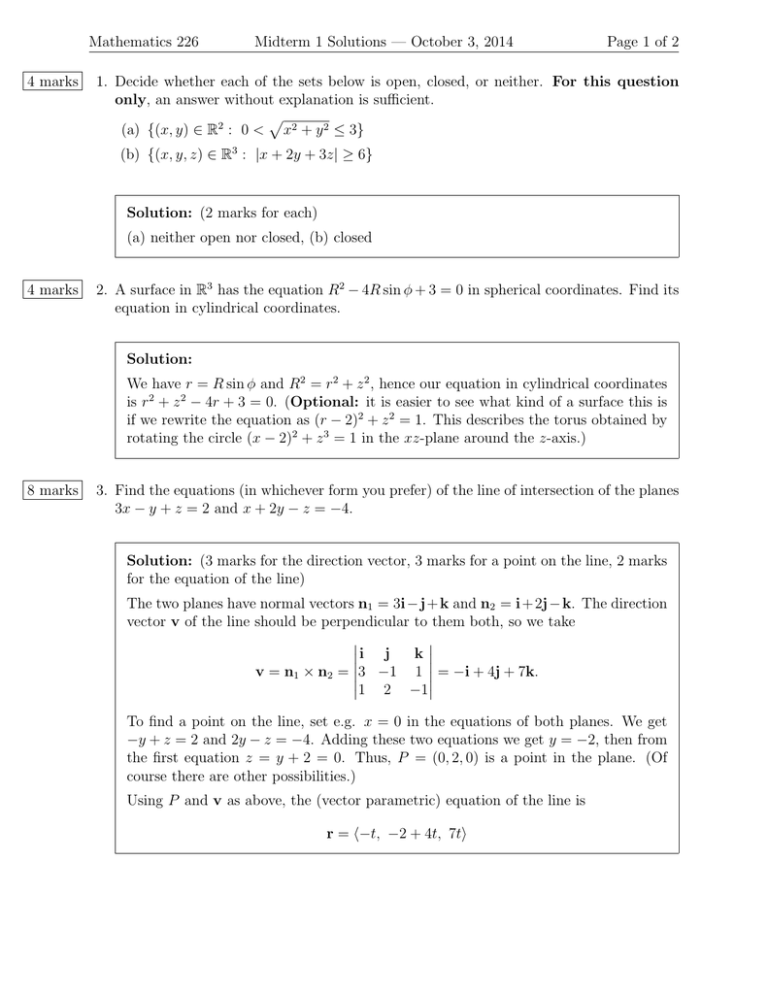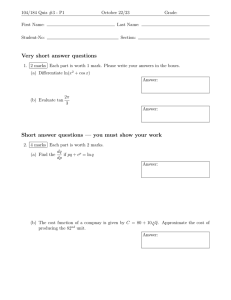Mathematics 226 Midterm 1 Solutions — October 3, 2014 1.
advertisement

Mathematics 226
4 marks
Midterm 1 Solutions — October 3, 2014
Page 1 of 2
1. Decide whether each of the sets below is open, closed, or neither. For this question
only, an answer without explanation is sufficient.
p
(a) {(x, y) ∈ R2 : 0 < x2 + y 2 ≤ 3}
(b) {(x, y, z) ∈ R3 : |x + 2y + 3z| ≥ 6}
Solution: (2 marks for each)
(a) neither open nor closed, (b) closed
4 marks
2. A surface in R3 has the equation R2 − 4R sin φ + 3 = 0 in spherical coordinates. Find its
equation in cylindrical coordinates.
Solution:
We have r = R sin φ and R2 = r2 + z 2 , hence our equation in cylindrical coordinates
is r2 + z 2 − 4r + 3 = 0. (Optional: it is easier to see what kind of a surface this is
if we rewrite the equation as (r − 2)2 + z 2 = 1. This describes the torus obtained by
rotating the circle (x − 2)2 + z 3 = 1 in the xz-plane around the z-axis.)
8 marks
3. Find the equations (in whichever form you prefer) of the line of intersection of the planes
3x − y + z = 2 and x + 2y − z = −4.
Solution: (3 marks for the direction vector, 3 marks for a point on the line, 2 marks
for the equation of the line)
The two planes have normal vectors n1 = 3i − j + k and n2 = i + 2j − k. The direction
vector v of the line should be perpendicular to them both, so we take
i j
k
v = n1 × n2 = 3 −1 1 = −i + 4j + 7k.
1 2 −1
To find a point on the line, set e.g. x = 0 in the equations of both planes. We get
−y + z = 2 and 2y − z = −4. Adding these two equations we get y = −2, then from
the first equation z = y + 2 = 0. Thus, P = (0, 2, 0) is a point in the plane. (Of
course there are other possibilities.)
Using P and v as above, the (vector parametric) equation of the line is
r = h−t, −2 + 4t, 7ti
Mathematics 226
4 marks
Midterm 1 Solutions — October 3, 2014
Page 2 of 2
4. Find the volume of the parallelepiped in R3 spanned by the vectors i − j + 4k, 3j − k,
2i + j.
Solution: (2 marks for using the correct formula, 2 marks for evaluating the determinant correctly)
1 −1 4 V = abs 0 3 −1 = |1 · 1 + 1 · 2 + 4 · (−6)| = | − 21| = 21
2 1
0
12 marks
5. Let
xy 3
f (x, y) = x2 + y 2
0
if (x, y) 6= (0, 0)
if (x, y) = (0, 0)
(a) (8 marks) Does f have a limit at (0, 0)? Explain your answer.
Solution: (2 marks for the correct answer, 6 for the explanation.)
p
p
Since |x| ≤ x2 + y 2 and |y| ≤ x2 + y 2 , we have for all (x, y) 6= (0, 0)
xy 3 (x2 + y 2 )2
2
2
x2 + y 2 ≤ x2 + y 2 = x + y .
Since x2 + y 2 → 0 as (x, y) → (0, 0), the function has limit 0 at that point. (In
2
2
terms of δ and
p , to ensure
√ if x + y < δ, or
√ that |f (x, y) − 0| < δ, it suffices
equivalently, x2 + y 2 < δ. Therefore we can take = δ.)
(b) (4 marks) Find
∂f
∂f
(0, 0) and
(0, 0), or else explain why they do not exist.
∂x
∂y
Solution: We have f (x, 0) = 0 for all x and f (0, y) = 0 for all y, so that
fx (0, 0) = 0 and fy (0, 0) = 0.
8 marks
6. Find the equation of the tangent plane to the surface z = 5x2 y − y 2 at the point where
x = −1, y = 3.
∂z
∂z
Solution: (4 marks for ∂x
(−1, 3) and ∂x
(−1, 3), 2 for using the correct equation of
the plane, 2 for plugging in everything correctly.)
∂z
∂z
We have
= 10xy and
= 5x2 − 2y. Thus at (x, y) = (−1, 3), z = 15 − 9 = 6,
∂x
∂y
∂z
∂z
= −30, and
= 5 − 6 = −1. Thus the equation of the tangent plane is
∂x
∂y
z = 6 − 30(x + 1) − (y − 3)
which simplifies to z = −30x − y − 21.








